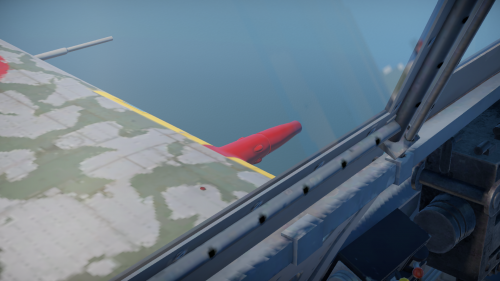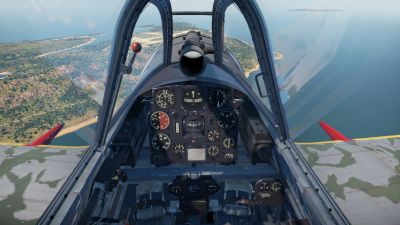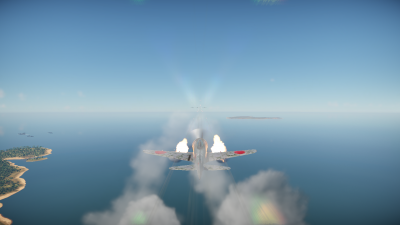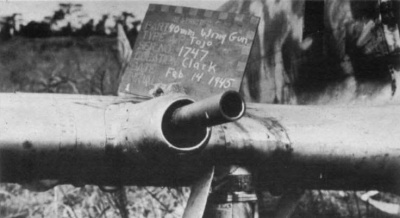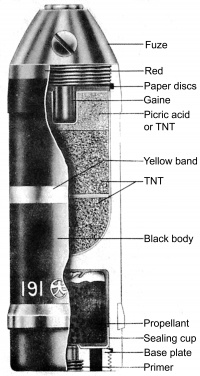Difference between revisions of "Ho-301 (40 mm)"
(Tag: Visual edit) |
Colok76286 (talk | contribs) (Edits) |
||
| (7 intermediate revisions by 4 users not shown) | |||
| Line 1: | Line 1: | ||
| + | [[File:Ho-301 mounted on Ki-44-II otsu.png|alt=40mm Ho-301 cannon in the left wing of the Ki-44-II otsu|right|thumb|500px|Ho-301 cannon in the left wing of the Ki-44-II otsu, painted in red]] | ||
| + | |||
== Description == | == Description == | ||
| − | ''Write an introduction to the article in 2-3 small paragraphs. Briefly tell us about the history of the development and combat using the weaponry and also about its features. Compile a list of air, ground, or naval vehicles that feature this weapon system in the game.'' | + | <!-- ''Write an introduction to the article in 2-3 small paragraphs. Briefly tell us about the history of the development and combat using the weaponry and also about its features. Compile a list of air, ground, or naval vehicles that feature this weapon system in the game.'' --> |
| + | The Ho-301 is a Japanese 40 mm aircraft cannon intended for the anti-bomber role. It is unusual as it uses low velocity caseless ammunition and is solely mounted on the Ki-44-II otsu in-game. | ||
| + | [[File:Ki-44-II otsu cockpit.png|alt=Cockpit of the Ki-44-II otsu|thumb|400x400px|Two Ho-301 cannons on the Ki-44-II otsu]] | ||
=== Vehicles equipped with this weapon === | === Vehicles equipped with this weapon === | ||
| Line 8: | Line 12: | ||
== General info == | == General info == | ||
| − | ''Tell us about the tactical and technical characteristics of the cannon or machine gun.'' | + | <!-- ''Tell us about the tactical and technical characteristics of the cannon or machine gun.'' --> |
| + | The Ho-301 has a relatively low fire rate and its rounds have very low velocity. Due to the design of the weapon and its ammunition, accuracy is poor at any range. The low ammunition count will cause this weapon to run dry in slightly less than two seconds of firing time. | ||
| − | === Available | + | === Available ammunition === |
| − | ''Describe the shells that are available for the | + | <!-- ''Describe the shells that are available for the weapon and their features and purpose. If it concerns autocannons or machine guns, write about different ammo belts and what is inside (which types of shells).'' --> |
| + | |||
| + | * '''Default:''' {{Annotation|HEF|High-explosive fragmentation}} | ||
| + | |||
| + | {{:{{PAGENAME}}/Ammunition|HEF}} | ||
| + | |||
| + | [[File:Ho-301 firing, Ki-44-II otsu.png|alt=Ho-301 firing, Ki-44-II otsu|thumb|400x400px|Ho-301s firing, displaying very large muzzle blasts]] | ||
=== Comparison with analogues === | === Comparison with analogues === | ||
| − | ''Give a comparative description of cannons/machine guns | + | <!-- ''Give a comparative description of cannons/machine guns that have firepower equal to this weapon.'' --> |
| + | Due to this weapon's unique properties, it has very few true analogues in game. In fact, because of its low velocity rounds and high explosive mass, it is almost more similar to grenade launchers like the helicopter-mounted 40 mm [[M129 (40 mm)|M129]] than it is to other large calibre aircraft cannons. | ||
| + | |||
| + | Compared to the rest of its class of bomber-destroying weapons, the Ho-301 has one of the lowest velocity rounds, largest bullet spread, and has some of the smallest ammunition count of its type. | ||
== Usage in battles == | == Usage in battles == | ||
| − | ''Describe the cannon/machine gun in the game - its distinctive features, tactics of usage against | + | <!-- ''Describe the cannon/machine gun in the game - its distinctive features, tactics of usage against notable opponents. Please don't write a "guide" - do not impose a single point of view, but give the reader food for thought.'' --> |
| + | When using the Ho-301, it is recommended to manoeuvre very close behind the enemy aircraft to increase the chances of shells hitting the target. On the [[Ki-44-II otsu]], these cannons act like secondary weapons as backup to the twin 12.7 mm [[Ho-103 (12.7 mm)|Ho-103]] machine guns. This weapon requires a significant amount of lead, even if the target is in straight and level flight. It is recommended to utilize the Ki-44-II otsu's agility to manoeuvre the rounds on target. As the Ho-301 was intended to be used against bombers, it is advised to use it as such if the pilot is intending to use this cannon as their main weapon. | ||
| + | |||
| + | It is not recommended to use the Ho-301 to attack ground or naval targets due to its very limited ammunition pool and poor accuracy. Its high explosive rounds, while having a great explosive filler, will only be able to damage unarmoured or open top targets. | ||
=== Pros and cons === | === Pros and cons === | ||
| − | '' | + | <!-- ''Summarise and briefly evaluate the weaponry in terms of its characteristics and combat effectiveness. Mark pros and cons as a list.'' --> |
'''Pros:''' | '''Pros:''' | ||
| − | * | + | * Shells have high explosive mass and can obliterate aircraft components |
* Effective versus heavy aircraft | * Effective versus heavy aircraft | ||
| − | * | + | * Due to the [[Ki-44-II otsu]] being rarely encountered and looking nearly identical to other [[Ki-44 (Family)|Ki-44]]<nowiki/>s, enemy players may not expect to be attacked with this weapon |
| − | + | * Recoil can be used to slow the aircraft down | |
| − | * | ||
'''Cons:''' | '''Cons:''' | ||
* Slow fire rate | * Slow fire rate | ||
| − | * Poor accuracy | + | * Poor accuracy |
| − | * Massive recoil makes aiming | + | * Low muzzle velocity |
| + | * Massive recoil makes aiming difficult | ||
| + | * Recoil will slow the aircraft down | ||
| + | * Very limited ammunition count | ||
| + | * Unusual performance may make it difficult to learn how to use | ||
| + | * No armour piercing ammunition for use against armoured targets | ||
| + | |||
| + | == History == | ||
| + | <!-- ''Examine the history of the creation and combat usage of the weapon in more detail than in the introduction. If the historical reference turns out to be too long, take it to a separate article, taking a link to the article about the weapon and adding a block "/History" (example: <nowiki>https://wiki.warthunder.com/(Weapon-name)/History</nowiki>) and add a link to it here using the <code>main</code> template. Be sure to reference text and sources by using <code><nowiki><ref></ref></nowiki></code>, as well as adding them at the end of the article with <code><nowiki><references /></nowiki></code>.'' --> | ||
| + | [[File:Ho-301 cannon on Tojo fighter, (1945).jpg|alt=Ho-301 cannon on Tojo fighter, (1945)|thumb|400x400px|Photo of captured "40 mm Wing Gun" on "Tojo", February 14, 1945]] | ||
| + | Intended as an anti-bomber weapon, the Ho-301 is an unusual cannon that uses caseless ammunition. It saw limited use, mounted on specialized Ki-44 and Ki-45 aircraft variants and deployed against Allied forces in defense of the Japanese home islands. | ||
| + | |||
| + | The rounds use an aluminum cup to carry the projectile along with a silk bag holding the propellant and primer. When the primer is struck, the bag of propellant is ignited but the projectile is not launched from the chamber until the pressure causes the cup to burst through exhaust holes in the base. | ||
| + | |||
| + | The Ho-301 suffered from a low velocity and was only effective against bombers close ranges within 150 meters which would cause the aircraft to adopt a position well within range of enemy defensive weapons. | ||
| − | + | Despite its drawbacks, the Ho-301 became one of the few caseless ammunition weapons to see service with any nation. | |
| − | = | + | [[File:Ho-301 40 mm caseless projectile.jpg|alt=Diagram of 40 mm projectile for Ho-301 aircraft cannon|thumb|376x376px|Diagram of the 40 mm caseless ammunition]] |
| − | |||
== Media == | == Media == | ||
| − | '' | + | <!-- ''Excellent additions to the article would be video guides, screenshots from the game, and photos.'' --> |
| + | |||
| + | ;Videos | ||
| + | {{Youtube-gallery|Q3vR2Vn4xaM|'''The slowest guns in War Thunder {{!}} Ki-44 II Otsu''' - ''Joob''}} | ||
== See also == | == See also == | ||
| − | ''Links to the articles on the War Thunder Wiki that you think will be useful for the reader, for example:'' | + | <!-- ''Links to the articles on the War Thunder Wiki that you think will be useful for the reader, for example:'' |
| + | * ''reference to the article about the variant of the cannon/machine gun;'' | ||
| + | * ''references to approximate analogues by other nations and research trees.'' --> | ||
| + | |||
| + | '''Weapons of the same calibre and similar role''' | ||
| + | |||
| + | * [[Rolls-Royce Type BH (40 mm)|Rolls-Royce Type BH]] | ||
| + | * [[Vickers S (40 mm)|Vickers S]] | ||
| − | + | '''Weapons of a similar role''' | |
| − | * | + | |
| + | * [[Ho-203 (37 mm)]] | ||
| + | * [[NS-45 (45 mm)]] | ||
== External links == | == External links == | ||
| − | ''Paste links to sources and external resources, such as:'' | + | <!-- ''Paste links to sources and external resources, such as:'' |
| + | * ''topic on the official game forum;'' | ||
| + | * ''other literature.'' --> | ||
| − | * | + | * [[wikipedia:Ho-301_cannon|[Wikipedia] Ho-301]] |
| − | * | + | * [https://www.bulletpicker.com/pdf/TM%209-1985-5,%20Japanese%20Explosive%20Ordnance.pdf TM 9-1985-5, Japanese Explosive Ordnance] (pg.296) |
| − | |||
{{Japan aircraft cannons}} | {{Japan aircraft cannons}} | ||
[[Category:Aircraft cannons]] | [[Category:Aircraft cannons]] | ||
Latest revision as of 08:31, 29 December 2023
Contents
Description
The Ho-301 is a Japanese 40 mm aircraft cannon intended for the anti-bomber role. It is unusual as it uses low velocity caseless ammunition and is solely mounted on the Ki-44-II otsu in-game.
Vehicles equipped with this weapon
General info
The Ho-301 has a relatively low fire rate and its rounds have very low velocity. Due to the design of the weapon and its ammunition, accuracy is poor at any range. The low ammunition count will cause this weapon to run dry in slightly less than two seconds of firing time.
Available ammunition
- Default: HEF
| Penetration statistics | |||||||
|---|---|---|---|---|---|---|---|
| Ammunition | Penetration @ 0° Angle of Attack (mm) | ||||||
| 10 m | 100 m | 500 m | 1,000 m | 1,500 m | 2,000 m | ||
| HEF | 3 | 3 | 3 | 3 | 3 | 3 | |
| Shell details | ||||||||||||
|---|---|---|---|---|---|---|---|---|---|---|---|---|
| Ammunition | Velocity (m/s) |
Projectile mass (kg) |
Fuse delay (m) |
Fuse sensitivity (mm) |
Explosive mass (TNT equivalent) (g) |
Ricochet | ||||||
| 0% | 50% | 100% | ||||||||||
| HEF | 246 | 0.59 | 0.4 | 0.3 | 56 | 79° | 80° | 81° | ||||
Comparison with analogues
Due to this weapon's unique properties, it has very few true analogues in game. In fact, because of its low velocity rounds and high explosive mass, it is almost more similar to grenade launchers like the helicopter-mounted 40 mm M129 than it is to other large calibre aircraft cannons.
Compared to the rest of its class of bomber-destroying weapons, the Ho-301 has one of the lowest velocity rounds, largest bullet spread, and has some of the smallest ammunition count of its type.
Usage in battles
When using the Ho-301, it is recommended to manoeuvre very close behind the enemy aircraft to increase the chances of shells hitting the target. On the Ki-44-II otsu, these cannons act like secondary weapons as backup to the twin 12.7 mm Ho-103 machine guns. This weapon requires a significant amount of lead, even if the target is in straight and level flight. It is recommended to utilize the Ki-44-II otsu's agility to manoeuvre the rounds on target. As the Ho-301 was intended to be used against bombers, it is advised to use it as such if the pilot is intending to use this cannon as their main weapon.
It is not recommended to use the Ho-301 to attack ground or naval targets due to its very limited ammunition pool and poor accuracy. Its high explosive rounds, while having a great explosive filler, will only be able to damage unarmoured or open top targets.
Pros and cons
Pros:
- Shells have high explosive mass and can obliterate aircraft components
- Effective versus heavy aircraft
- Due to the Ki-44-II otsu being rarely encountered and looking nearly identical to other Ki-44s, enemy players may not expect to be attacked with this weapon
- Recoil can be used to slow the aircraft down
Cons:
- Slow fire rate
- Poor accuracy
- Low muzzle velocity
- Massive recoil makes aiming difficult
- Recoil will slow the aircraft down
- Very limited ammunition count
- Unusual performance may make it difficult to learn how to use
- No armour piercing ammunition for use against armoured targets
History
Intended as an anti-bomber weapon, the Ho-301 is an unusual cannon that uses caseless ammunition. It saw limited use, mounted on specialized Ki-44 and Ki-45 aircraft variants and deployed against Allied forces in defense of the Japanese home islands.
The rounds use an aluminum cup to carry the projectile along with a silk bag holding the propellant and primer. When the primer is struck, the bag of propellant is ignited but the projectile is not launched from the chamber until the pressure causes the cup to burst through exhaust holes in the base.
The Ho-301 suffered from a low velocity and was only effective against bombers close ranges within 150 meters which would cause the aircraft to adopt a position well within range of enemy defensive weapons.
Despite its drawbacks, the Ho-301 became one of the few caseless ammunition weapons to see service with any nation.
Media
- Videos
See also
Weapons of the same calibre and similar role
Weapons of a similar role
External links
| Japan aircraft cannons | |
|---|---|
| 20 mm | Ho-1 · Ho-3 · Ho-5 · Type 99 Model 1 · Type 99 Model 2 |
| 30 mm | Ho-155 · Type 5 |
| 37 mm | Ho-203 · Ho-204 · Type 94 |
| 40 mm | Ho-301 |
| 57 mm | Ho-401 |
| 75 mm | Type 88 |
| Foreign: | |
| 20 mm | M39A3 (USA) · M61A1 (USA) · M197 (USA) · MG FF (Germany) · MG FF/M (Germany) · MG 151 (Germany) |
| 30 mm | GAU-13/A (USA) · M230E-1 (USA) |


